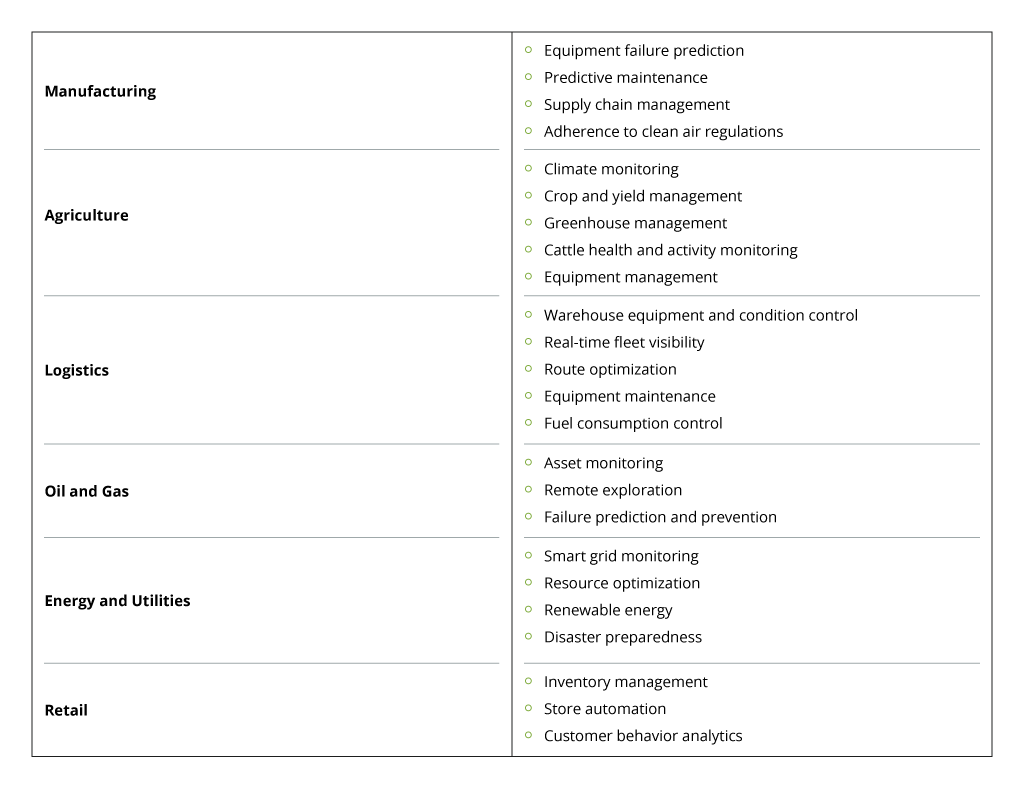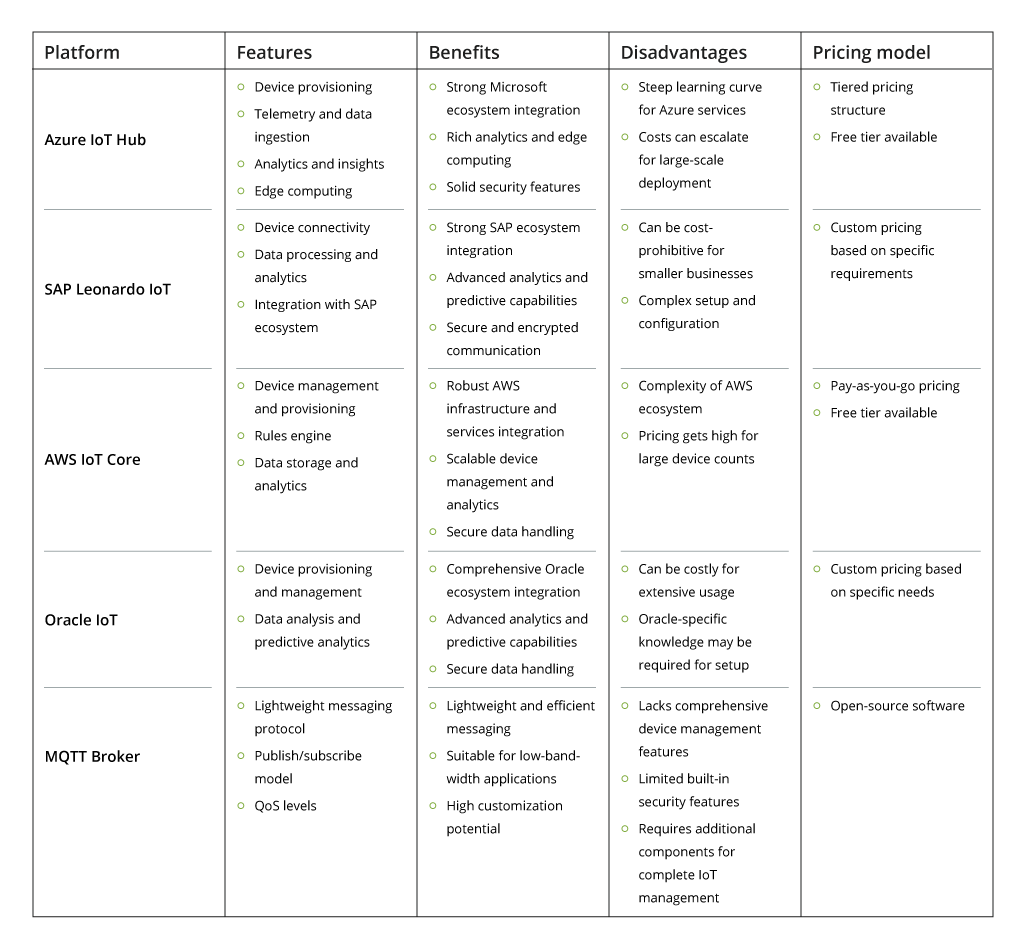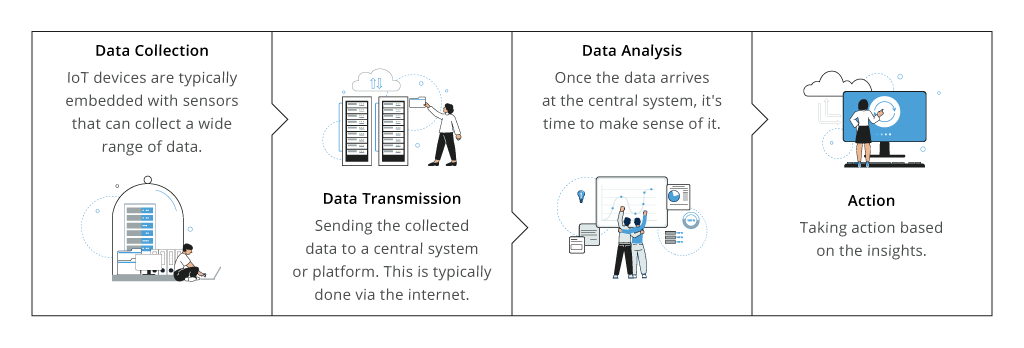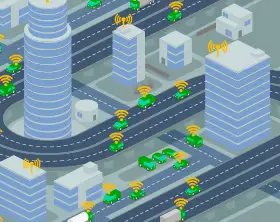How to Enable IoT Remote Device Management at Scale?
So, what is remote IoT device management, and how does it help businesses across industries? In this article, we will uncover the benefits of deploying remote IoT device management for various industry segments. We’ll also investigate the challenges related to scaling it and discover practical tips for addressing them effectively.
What Is Remote IoT Device Management?
Managing IoT devices involves a sequence of processes for equipping, validating, configuring, monitoring, and analyzing the connected devices within an IoT infrastructure. The primary goal of remote management is delivering and bolstering the complete range of the devices’ functional capabilities. It requires a reliable and efficient solution for managing remote IoT devices to maintain stable connectivity, security, and up-to-date status of all the sensor-equipped assets.
When You Need Remote IoT Device Management

How Does It Work?
The IoT remote monitoring is implemented with various technologies and components to enable the seamless connection, data transmission, and analysis with the help of remote IoT device management software.
The entire monitoring system of IoT devices includes the following components:
- Sensors and Devices: Various sensors (temperature, humidity, pressure, motion sensors, GPS modules, etc.) are embedded into different machines and assets to monitor their state and performance.
- Connectivity: Data collected from sensors are transmitted to a gateway for further processing. Data can be transmitted via cellular networks (2G/3G/4G/5G), Wi-Fi, Bluetooth, Zigbee, LoRaWAN, or satellite communication based on the device location and other requirements.
- Data Transmission: The data is transmitted in real-time or at regular intervals, which is defined by the data urgency and specific use cases.
- Cloud Platform or Edge Computing: Data from sensors is collected, stored, and processed on either a cloud-based platform or an edge computing system.
- Data Analysis: Various analytics tools and algorithms are used to extract valuable patterns and insights for remote IoT device management. All the information is saved in databases for historical records and further analysis.
- Visualization: The insights retrieved from data are presented to end-users through a user-friendly interface in the form of dashboards, reports, chatbot notifications, and others.
- Remote Control: With the growth of sensors and devices, the IoT monitoring system may also need remote control features to manage devices from a remote location.
- Automation: Scalable systems highly rely on the automation of IoT device management to optimize the time and effort required to keep all IoT-based processes up and running.
The last two components are optional yet essential for scaling up the remote IoT device management within the growth of production facilities, areas of operation, and the number of IoT devices, respectively.
The Uses of Remote IoT Device Management across Industries
The industries have already succeeded in IoT implementation and continue to increase the level of its adoption. For example, the global industrial IoT market is forecasted to reach $1,562 billion by 2032 from $320.billion in 2022. Incorporating IoT together with remote management practices help optimize essential processes and address numerous challenges in different industry segments. Here are the most popular use cases of remote IoT device management across industries:

To make the technology solve your business needs effectively, a remote IoT device management system needs to be scalable. It has to fit the growing data loads, requirements in its processing speed, and security and compliance regulations. While deploying such systems is already a common practice, scaling them depending on the growing business and operational demands imposes a range of complexities and challenges.
What Hampers Scaling Remote IoT Device Management?
When a company is just beginning to use IoT technology, they often start with a pilot project that involves managing a limited number of sensors and devices. With the growth of facilities and the number of IoT sensors and devices, the deployed infrastructure may no longer keep up with the growing number of devices and data they produce. Here are the major challenges to scaling up remote IoT device management:
- The complexity of device provisioning: As each IoT device needs to be set up with unique identifiers, network connectivity, security parameters, and programmed rules for classifying their performance, manual provisioning becomes more and more error-prone and time-consuming.
- Ensuring security: Within the increasing fleet of devices, managing security requirements and vulnerabilities of each connected device type and item becomes more complicated. The growing amount of collected and processed data also requires additional measures to ensure data protection and integrity. Read more about how to enforce staunch security for IoT systems with Microsoft Defender.
- Compatibility and interoperability of devices: The diversity of shapes, sizes, communication protocols, and manufacturers of the IoT devices within one enterprise can affect their seamless communication with the centralized management system for remote control and maintenance.
- Data overload: The initial data warehouse setup and data analytics tools may lack the capacity to effectively store and maintain the growing data volume, diversity, and velocity.
- Network connectivity and reliability: If the enterprise deals with limited network coverage, which is typical for big agricultural or mining companies, ensuring efficient and reliable communication between all the devices and the data management system becomes a complex undertaking.
- Power management: Numerous IoT devices and sensors deal with limited power sources, and their battery life should be adequately tracked and maintained. Big device fleets require efficient power management and data transmission techniques to maximize uptime.
- Infrastructure scalability: For handling the increasing number of devices and loads of data, the remote IoT device management infrastructure needs to be scalable in terms of storage capacity, edge computing capabilities, and other parameters.
- Cost management: More devices imply more expenses in keeping them up and running and effectively solving the business tasks. Choosing the right remote IoT device management software and licensing, and deploying robust automation are crucial here to maintain the system cost-efficiency.
- Monitoring, diagnostics, and maintenance of devices: Detecting anomalies, preventing potential issues, remote diagnostics and troubleshooting issues, maintaining and updating IoT devices – all this requires proactive management and scalable infrastructure.
From the technical side, integrating the remote IoT device management system with the existing legacy systems also implies scalability challenges, as the outdated enterprise infrastructure can lack the resources for seamless integration and interoperability. This and other mentioned hurdles should be well-thought-of in the discovery phase of the solution design to avoid potential failures in the future.
How to Address Scalability Issues in Remote IoT Device Management?
The scalability of the Remote IoT device management system highly depends on how the solution was initially designed and implemented. Besides quantitative parameters like data amount, number of devices, their allocation, and others, understanding the nature of processes and needs of the specific industry, enterprise, and production cycles is essential. In each use case you will need to prioritize the effort and budget for maximum performance and cost efficiency. Here is the essential step-by-step workflow to minimize the potential scalability issues.
- Define business needs and goals: What challenges must be solved with the future system? For example, these can be minimizing downtime, ensuring fault-tolerant equipment performance, high-quality operations execution, maximizing productivity without harnessing the product quality, and many others. Prioritize your goals that will further help optimize the effort and budget for achieving them.
- Consider the areas of scale: When planning the capacity for future growth, it’s recommended to analyze how exactly your device fleet or processes will expand in the future. For example, it can be the expansion of the device fleet, new device types and new processes being added.
- Ensure scalable data management: The remote IoT device management software and data warehouse should allow for the capacity increase to cover the scalability needs. It also needs automation and data processing capabilities to cope with the planned data volumes.
- Choose the right platform: Based on the analyzed needs and plans for expansion, choose the suitable platform for secure remote management of the IoT device fleet. Consider the license pricing: the chosen solution should also fit your budget.
- Configure and deploy the entire IoT device management infrastructure for convenience at scale. Ensure regular firmware and software updates based on the specificity of supported IoT devices and system requirements.
- Implement automation and orchestration to streamline repetitive tasks and ensure convenient IoT device performance tracking.
- Develop efficient incident monitoring and response. The existing systems for IoT device management commonly provide basic monitoring capabilities that must be expanded when scaling the system up for more devices. Manual monitoring of numerous data reports to detect possible anomalies is inefficient and error-prone. That is why engineers at Infopulse enrich such systems with chatbots and incident filters to ensure the timely response to potential and actual incidents.
- Equip your team with the necessary skills to troubleshoot issues and perform routine system maintenance.
- Constantly assess the performance and quality of your IoT deployment against predefined goals to timely detect if any adjustments are needed with the growing scale.
All these steps help create an efficient management system for remote IoT devices, staying viable in the long run. Keeping the system up and running with the growing loads is a continuous process with a proactive approach to adapt to changes and new business needs.
Platforms for Scalable Remote IoT Device Management
While developing the pilot IoT solution, the overall project price is less accounted for. Yet, when moving to the production stage, with scalability in mind, pricing becomes essential. It is also essential to analyze features like available data volumes, types of IoT devices to be managed, required connectivity protocols, the quality of internet connectivity, and others.
Choosing the right platform should be a balanced solution based on the features, advantages and disadvantages of each platform, and the pricing model. All these characteristics should also correspond to the changing needs of the business. Here is a brief review of the most popular platforms for IoT management to see the key differences:

Besides the remote IoT device management platform, the infrastructure must include the data lake or digital warehouse, tools for warm and cold data analytics like Data Bricks, Apache Sparks, Azure Synapse, and others.
Conclusion
Remote management of IoT devices enhances productivity and helps optimize resources for numerous IoT-related processes across industries. In this article, we highlighted the issues that appear when such systems are scaled up and the ways to address them:
- Deep understanding of the business goals, the enterprise peculiarities, and the nature of its operational processes
- Planning system resources for further scalability during the project discovery phase
- Choosing the suitable remote IoT device management platform to maintain the growing scale
- Time- and budget-wise implementation with custom improvements to cover the enterprise specificity
- Constant monitoring of the system performance with timely updates and troubleshooting.
IoT engineers at Infopulse perform the full scope of the IoT infrastructure development, implementation, and support, choosing the optimum stack of technologies and tools for the individual needs of any business. With a detailed and in-depth requirements analysis and all necessary calculations for future scaling, our team delivers a cost-effective and reliable remote IoT device management solution for any IoT device fleet size.






![IoT as the Core of Digital Farming and Agriculture [thumbnail]](/uploads/media/280x222-iot-as-the-core-of-digital-farming-and-agriculture.webp)
![Defender for IoT [thumbnail]](/uploads/media/thumbnail-280x222-how-to-ensure-Iot-and-ot-security98.webp)




